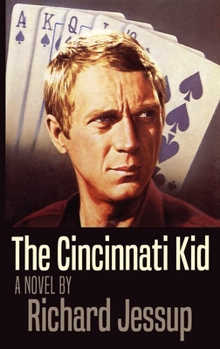The Cincinnati Kid
Select Format
Select Condition 
Book Overview
The Cincinnati Kid, first published in 1963 (and made into a feature film starring Steve McQueen in 1965), is a gritty novel of smoky back-rooms and centered on a young card-shark ("The Kid") who eventually finds himself in a stud-poker game against the undisputed master ("The Man"). From the first edition dust-jacket: "By the time he was twenty-one, he was a full rambling-gambling man, a three river man. . . . From Jolly's Omaha...
Format:Paperback
Language:English
ISBN:B0CTVT2TVJ
ISBN13:9798869153401
Release Date:January 2024
Publisher:Nighthawk Books
Length:162 Pages
Weight:0.32 lbs.
Dimensions:0.3" x 4.7" x 7.5"
Customer Reviews
1 rating
All The Way Up For Poker Lovers
Published by Thriftbooks.com User , 14 years ago
Other books use a sporting interest as a metaphor for their approach to life. In "The Cincinnati Kid", for the most part, poker is the message. Poker's not just a game to the fellow they call the Cincinnati Kid. It's what gives his life meaning. Now the time has come for him to make his play for the big time and take on the best stud player in the business, the one they call "The Man". "Sometime or other, we gotta find out how much juice we got," says his friend, Shooter, a top player who had his shot against the best only to lose to someone who lost to the Man. Published in 1963, "The Cincinnati Kid" was according to Wikipedia inspired by the pool-hall-based film "The Hustler" and would go on to become a successful movie of its own, to my mind not only a great one but the best Steve McQueen ever did. "Cincinnati Kid" the novel touches on similar themes of isolation, the elation of victory, and the desolation of defeat. Grittiness is emphasized. When we meet the Kid, we are told not only of his thin build, blue eyes, and sharp nose, but yellow half-circles under his eyes that speak to late nights of heavy drinking and cigarettes. He brings Murine and Listerine with him to the game, knowing well the toll of playing over the course of several days straight. But will he be able to stay cool when he think he's got the Man on the ropes? Richard Jessup doesn't begrudge the Kid his ways. He presents him instead as a figure of admiration, living his life "all the way up" in the same way Ernest Hemingway wrote of bullfighters. A very Hemingway-conscious style of terse narrative and run-on sentences predominates here, which might come off self-conscious except it suits the story and Jessup does it well, like when he describes the city of St. Louis where the story is set: "A hot city, slaked out on the banks of the Mississippi, with too much of its muscle showing to be a dignified city." Occasionally Jessup gets happy with the metaphors - "The cards sliced through the smoky airless room like silent stealing death" - but he also captures a mood of tough-nosed optimism that adds something to the story for those of us who have seen the movie. While the bare bones with both are the same, a lot of the subplots from the movie were added in the screenplay, not to mention moving the setting from then-present-day St. Louis to 1930s New Orleans. Some of the social intricacies of the poker-playing livelihood are examined at length - giving money for your girl to spend is called "change" so as to be distinguished from the money used to ante up, the "stake". Otherwise, what you have is 50 pages on setting up the story, 50 pages on the setting of the match, and then the last 50 pages of the Kid playing The Man for all he's worth. The only detour is a good one, involving the Kid's trying to deal with the question of his woman Christian, whom he cares for more than he wants to admit but is willing to lose for fear of losing his edge. "The Cincinnati Kid" is the kin






